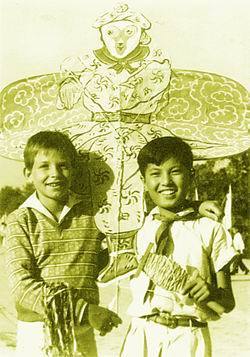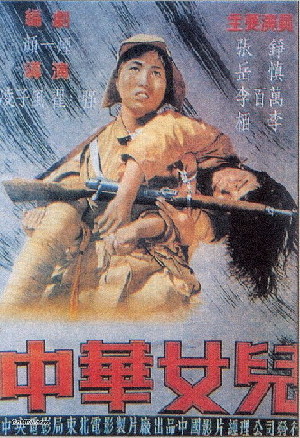| |
III. Embrace the world with the Kite
The Chinese Communist Party and government have always stressed cooperating with foreign partners to shoot films. In the early years of New China, China worked with the Soviet Union to shoot large-scale documentary films Victory of the Chinese People and Liberated China. They played a significant role to expand the influences of New China and develop friendly ties with other countries.

The Kite
On March 20, 1958, Beijing Film Studio worked with a French film studio to jointly shoot Kite, a feature movie eulogizing pure friendship between Chinese and French children (It won an honorary award at the 11th Karlovy Vary International Film Festival and the St. George Prize at the 19th Venice International Film Festival in 1958). It was the first feature movie that China shot along with a foreign partner. Since then, China set out to have films co-produced with foreign partners. In the second year, it worked with the Soviet Union to shoot a feature movie Wind from the East.
IV. Sponsor film festivals in each other’s country
In the wake of establishing New China, film exchanges with the outside world became a priority in the agenda of the people’s government. From December 11 to 18, 1950, the foreign cultural exchange bureau under the Ministry of Culture sponsored the first Film Week from People’s Democratic Countries in Beijing, introducing films from Czechoslovakia, Hungary, Romania, Bulgaria, Democratic Germany, Poland, DPRK, and Vietnam. It became a film exchange activity with the nature of an international film festival. In 1951, the China Film Management Corporation was established to unify the operation and management of importing and exporting films, and film exchanges with other countries. It unveiled large-scale communication with the international film sector.
From 1951 to 1954, China exhibited films from the Soviet Union, Czechoslovakia, Hungary, Bulgaria, Poland, Democratic Germany and Romania. Afterwards, it held film weeks of Japan, France, Italy and Mexico.
According to the principle of equality, the capitals of the 16 constituent republics of the United Union simultaneously held a China Film Week in 1954. After that, Poland, DPRK and India sponsored China film weeks in succession. By 1965, more than 20 countries had held a total of 60 China film weeks or other activities exclusively reserved for Chinese films.
In accompany with importing films, China started to export films, since 1951, to the Soviet Union, eastern European countries, Burma and Indonesia, such as Children of China, Zhao Yiman, White Haired Girl. Shining with Boundless Radiance. These films were well received by local audiences, enabling the people in these countries to understand the revolutionary struggles of the Chinese people and the birth of People’s Republic of China, and winning their sympathy and support towards the Chinese revolution.
The Chinese films were welcomed and appraised by foreign audiences and film industry insiders for their revolutionary and inspiring ideologies and growingly mature artistic styles. In the course of rapidly exporting films, China set about importing more foreign films. Since the mid 1950s, China purchased some films from capitalist countries with considerable ideological and artistic levels, in addition to importing films from the Soviet Union and eastern European countries each year. They included the Italian neo-realistic film The Bicycle Thief, Hamlet and Oliver Twist that were adapted from literary masterpieces in Britain, and Awara and Two Acres of Land from India. By 1966, China imported nearly 2,000 long and short films from about 50 countries.
Besides, China availed itself to existing films and document in words and pictures to actively promote the tremendous achievements in the Chinese film industry. In August 1958, the Chinese Film Archive, for the first time, participated in the Picture Show for the 60th Anniversary of World Films, sponsored by International Federation of Film Archives in East Berlin. The exhibited articles included 30 sets of stage photos on 23 films covering all historic stages, from An Orphan Rescues His Grandfather shot in 1923 to New Year Sacrifice, taken after the founding of New China, as well as stage properties.
V. Exchange of visits
To have the Chinese film industry make faster and greater progress and better serve the construction of New China, Chinese films must go global, exchange with more foreign partners, and participate in international film activities, so as to accumulate more experiences.

On July 15, 1950, New China’s film industry sent out its first film delegation to tap the international film sector in a brand-new image. It participated in the 5th Karlovy Vary International Film Festival in Czechoslovakia. The Chinese film Children of China won the Struggle for Freedom Prize. Shi Lianxing, who starred Zhao Yiman, won an international prize. Mighty Army across the Yangtze and four other documentaries won honorary titles. It was the first time for New China films to win prizes in international film festivals. It displayed the great vitality of the emerging Chinese films and opened up broad prospects for film exchanges with foreign countries.
|
|
